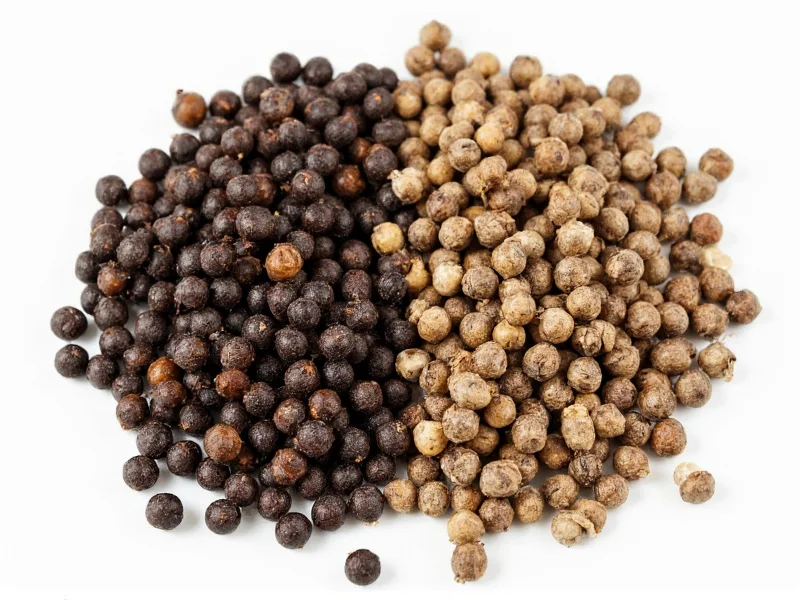Many home cooks and even experienced chefs wonder about the distinction between black pepper and peppercorns. This confusion stems from inconsistent labeling in grocery stores and varying terminology in recipes. Let's clarify this common culinary misconception with factual information about these essential kitchen staples.
Understanding Pepper Terminology
The term "peppercorn" refers to the raw fruit—technically a berry—of the Piper nigrum vine. These small, green berries grow in clusters similar to grapes. When harvested and processed in different ways, they become the various pepper varieties we use in cooking.
"Black pepper" specifically describes peppercorns that have undergone a particular processing method: the unripe green berries are briefly cooked in hot water, then spread out to dry in the sun. During this drying process, the outer layer (pericarp) turns black from enzymatic oxidation, creating what we know as black peppercorns.
The Pepper Family Tree
All true peppercorns come from the same plant species (Piper nigrum), with differences arising solely from harvest timing and processing methods. Here's how the main varieties relate:
| Pepper Type | Harvest Stage | Processing Method | Flavor Profile |
|---|---|---|---|
| Black Peppercorns | Unripe (green) | Cooked then sun-dried | Sharp, pungent, complex with floral notes |
| White Peppercorns | Ripe (red) | Soaked to remove outer layer, then dried | Milder, earthier, less complex |
| Green Peppercorns | Unripe (green) | Quickly dried or brined | Fresher, fruitier, more herbal |
| Pink Peppercorns | Ripe | Dried naturally | Sweet, resinous, not true pepper (different plant) |
Why the Confusion Exists
The misunderstanding between "black pepper" and "peppercorns" primarily comes from how these products are labeled and sold:
- Whole black peppercorns – These are the intact dried berries sold in spice jars
- Ground black pepper – These are the same peppercorns that have been milled into powder
- Peppercorn blends – Mixtures that may include black, white, green, and pink peppercorns
When recipes call for "peppercorns," they typically mean whole peppercorns of any variety, while "black pepper" usually refers to the ground form. However, technically speaking, black pepper begins its life as a peppercorn.
Culinary Applications and Recommendations
Understanding the relationship between peppercorns and black pepper helps you make better cooking decisions:
When to Use Whole Peppercorns
Whole peppercorns provide more nuanced flavor when used in slow-cooked dishes like soups, stews, and braises. The extended cooking time allows their complex flavors to infuse throughout the dish. They're also essential for making:
- Pickling brines
- Stocks and broths
- Crusts for meats (when coarsely cracked)
- Vinegars and infused oils
When to Use Ground Black Pepper
Ground black pepper works best when you need immediate, consistent seasoning. It's ideal for:
- Finishing dishes
- Dry rubs
- Sauces and dressings
- Quick-cooking recipes
For maximum flavor, always grind peppercorns fresh using a pepper mill. Pre-ground pepper loses its volatile oils and aromatic compounds within days, resulting in significantly diminished flavor.
Storage Tips for Maximum Freshness
To preserve the flavor of both whole peppercorns and ground black pepper:
- Store in airtight containers away from light and heat
- Keep whole peppercorns in opaque containers
- Use within 1 year for whole peppercorns, 6 months for ground pepper
- Never store near the stove or in clear containers on spice racks
Common Misconceptions Clarified
Myth: Black peppercorns and black pepper are different spices.
Fact: Black pepper is the ground form of black peppercorns. They're the same spice at different processing stages.
Myth: More expensive pepper is always better quality.
Fact: Price often reflects origin and harvest method rather than inherent quality. Freshly ground standard Tellicherry peppercorns often outperform expensive single-origin varieties that have been pre-ground.
Myth: All peppercorns come from the same plant.
Fact: True black, white, and green peppercorns come from Piper nigrum, but pink and Sichuan "peppercorns" are from completely different plant species.











 浙公网安备
33010002000092号
浙公网安备
33010002000092号 浙B2-20120091-4
浙B2-20120091-4